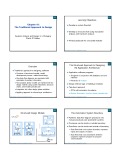
9
Chapter 9:
Moving to Design
Systems Analysis and Design in a Changing
World, 3rd Edition
9
Systems Analysis and Design in a Changing World, 3rd Edition 2
Learning Objectives
Discuss the issues related to managing and
coordinating the design phase of the SDLC
Explain the major components and levels of
design
Describe each design phase activity
Describe common deployment environments and
matching application architectures
Develop a simple network diagram and estimate
communication capacity requirements
9
Systems Analysis and Design in a Changing World, 3rd Edition 3
Overview
This chapter:
Completes the transition from analysis to design
Discusses issues related to design of new system
Describes all design phase activities
Describes network and architecture design
Analysis focuses on what system should do –
business requirements
Design is oriented toward how system will be built
–defining structural components
9
Systems Analysis and Design in a Changing World, 3rd Edition 4
Understanding the Elements of Design
Design is process of describing, organizing, and
structuring system components at architectural
design level and detailed design level
Focused on construction
Like developing blueprints
Three questions:
What components require systems design?
What are inputs to and outputs of design process?
How is systems design done?
9
Systems Analysis and Design in a Changing World, 3rd Edition 5
Components Requiring Systems Design
9
Systems Analysis and Design in a Changing World, 3rd Edition 6
Analysis Objectives to Design Objectives

9
Systems Analysis and Design in a Changing World, 3rd Edition 7
Moving from Analysis to Design
Design:
Converts functional models from analysis into
models that represent the solution
Focused on technical issues
Requires less user involvement than analysis
Design may use structured or OO approaches
Database can be relational, OO or hybrid
User interface issues
9
Systems Analysis and Design in a Changing World, 3rd Edition 8
Traditional Structured and Object-Oriented
Models
9
Systems Analysis and Design in a Changing World, 3rd Edition 9
SDLC Phases with Design Phase Activities
9
Systems Analysis and Design in a Changing World, 3rd Edition 10
Design Phase Activities and Key
Questions
9
Systems Analysis and Design in a Changing World, 3rd Edition 11
Design and Integrate the Network
Network specialists establish network based on
strategic plan
Project team typically integrates system into
existing network
Technical requirements have to do with
communication via networks
Technical issues handled by network specialists:
Reliability, security, throughput, synchronization
9
Systems Analysis and Design in a Changing World, 3rd Edition 12
Design the Application Architecture
Specify how system activities are carried out
Described during system analysis as logical
models
After design alternative is selected, detailed
computer processing is designed as physical
models such as: physical data flow diagrams,
structure charts, interaction diagrams
Approach varies depending on development and
deployment environments

9
Systems Analysis and Design in a Changing World, 3rd Edition 13
Design the User Interfaces
User interface quality is critical aspect of system
Design of user interface defines how user
interacts with system
GUI: windows, dialog boxes, mouse interaction
Sound, video, voice commands
To user of system, user interface is the system
User interface specialists: interface designers,
usability consultants, human factors engineers
9
Systems Analysis and Design in a Changing World, 3rd Edition 14
Design the System Interfaces
Systems interfaces enable systems to share and
exchange information
Internal organization systems
Interfaces with system outside organization
New system interfacing with package application
that organization has purchased and installed
System interfaces can be complex
Organization needs very specialized technical
skills to work on these interfaces
9
Systems Analysis and Design in a Changing World, 3rd Edition 15
Design and Integrate the Database
System analysis data model used to create
physical database model
Collection of traditional computer files, relational
database, and/or object-oriented databases
Technical requirements, such as response times,
determine database performance needs
Design work might involve:
Performance tuning
Integration between new and existing databases
9
Systems Analysis and Design in a Changing World, 3rd Edition 16
Prototype for Design Details
Continue to create and evaluate prototypes
during design phase
Prototypes confirm design choices:
Database
Network architecture
Controls
Programming environment
Rapid application development’s (RAD) design
prototypes evolve into finished system
9
Systems Analysis and Design in a Changing World, 3rd Edition 17
Design and Integrate the System Controls
Final design activity to ensure system has
adequate safeguards (system controls) to protect
organizational assets
Controls are needed for all other design activities
User interface –limit access to authorized users
System interface –protect from other systems
Application architecture –record transactions
Database –protect from software/hardware failure
Network design –protect communications
9
Systems Analysis and Design in a Changing World, 3rd Edition 18
Project Management: Coordinating the
Project
Coordinating Project Teams
Project schedule - coordinating ongoing work
The Project Team at RMO
As project team grows –structure may change
Coordinating Information
CASE tools and central repository
Team communication and information coordination
Track open items and unresolved issues

9
Systems Analysis and Design in a Changing World, 3rd Edition 19
System Development Information Stored in
the CASE Repository
9
Systems Analysis and Design in a Changing World, 3rd Edition 20
Deployment Environment
Deployment environment definition bridges
analysis and design
Hardware
System software
Networking
Common deployment environments in which
system will operate
Related design patterns and architectures for
application software
9
Systems Analysis and Design in a Changing World, 3rd Edition 21
Single, Clustered, and
Multicomputer Architectures
9
Systems Analysis and Design in a Changing World, 3rd Edition 22
Single-Computer and Multitier Architecture
Single-computer architecture
Mainframe-based
Limited by single machine capacity
Clustered and multi-computer architecture
Group of computers to provide processing and
data storage capacity
Cluster acts as a single system
Multicomputer hardware/OS can be less similar
than clustered
9
Systems Analysis and Design in a Changing World, 3rd Edition 23
Centralized and Distributed Architecture
Distributes system across several computers and
locations
Relies on communication networks for
geographic connectivity
Client-server architecture dominant model for
distributed computing
9
Systems Analysis and Design in a Changing World, 3rd Edition 24
Computer Networks
Set of transmission lines, specialized hardware,
and communication protocols
Enables communication among different users
and computer systems
Local area network (LAN) less than one kilometer
long –connects computers within single building
Wide area network (WAN) over one kilometer
long –implies much greater, global, distances
Router –directs information within network

9
Systems Analysis and Design in a Changing World, 3rd Edition 25
A Possible Network Configuration for RMO
9
Systems Analysis and Design in a Changing World, 3rd Edition 26
The Internet, Intranets, and Extranets
Internet –Global collection of networks that use
TCP/IP networking protocols
Intranets
Private networks using same TCP/IP protocol as
the Internet
Limited to internal users
Extranets
Intranet that has been extended outside the
organization
9
Systems Analysis and Design in a Changing World, 3rd Edition 27
Application Architecture
Consists of standards and tools used in an
organization
Important components
Language environment and expertise
Existing CASE tools and methodologies
Required interfaces to other systems
Operating system environment
Database management system environment
9
Systems Analysis and Design in a Changing World, 3rd Edition 28
Client-Server Architecture
Client-Server divides programs into two types
Server –manages information system resources
or provides well defined services for client
Client –communicates with server to request
resources or services
Advantage –Deployment flexibility
Location, scalability, maintainability
Disadvantage –Potential performance, security,
and reliability issues from network communication
9
Systems Analysis and Design in a Changing World, 3rd Edition 29
Interaction among Client, Server, and a
Service-Related Data Store
9
Systems Analysis and Design in a Changing World, 3rd Edition 30
Client-Server Architectural Process
Decompose application into client and server
programs, modules, or objects
Identify resources or services that can be centrally
managed by independent software units
Determine which clients and servers will execute
on which computer systems
Describe communication protocols and networks
that connect clients and servers


























